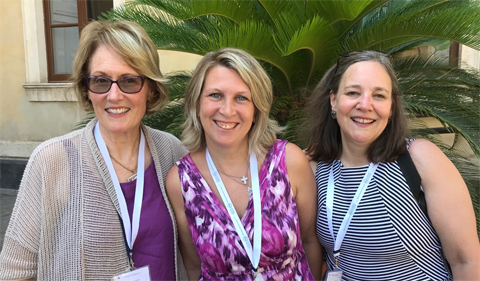
Dr. Theresa Moran, Dr. Cinzia Recca, University of Catania, Department of Educational Sciences, Local Conference Organizer, Dr. Miriam Shadis
Dr. Miriam Shadis, Associate Professor of History, Dr. Theresa Moran, Director of Food Studies, and Dr. David Bell, Chair of Linguistics presented papers at the Eighth Edition of the Kings and Queens Conference — Resilio ergo Regno: Resilience, Continuity and Recovery at Royal Courts.
The conference brings together scholars working in different disciplines with an interest in royal and court studies. The conference is part of the Royal Studies Network based at the University of Winchester. The network connects scholars working on monarchal topics in any geographical or temporal context not only through the Kings & Queens Conference series, but also through the Royal Studies Journal and a global, web-based community sharing ideas, research, publications, conference notices and events, according to its website.
The University of Catania, the oldest in Sicily, dates back to 1434 by the authorization of King Alfonso I of Sicily, who was also the king of Spain. The conference took place in the former Benedictine Monastery of San Nicolò, founded in 1355 and rebuilt following the earthquake of 1693.
Shadis’s paper, “Signs of use: ritual and Queenship in early Portugal,” examined the 12th century “Pontifical of Coimbra,” a manual used by the bishops of Coimbra in the reigns of Alfonso Henriques and Sancho I. The Pontifical includes procedures for the ritual blessing and coronation of a king, and also for a queen, a ritual in this latter case that has not to date been studied. If this pontifical were in fact used, the queenship rite would have applied to Dulce of Aragon (wife of Sancho I), or potentially Urraca, wife of Afonso II. As such, a study of this Pontifical allows tentative conclusions to be drawn about the formation of queenship in early Portugal.
This is the fourth time that Shadis has attended the Kings and Queens Conference over the nine years it has been meeting.
“It’s always a really interesting and congenial group of people who are interested in monarchy, courts, power, and so on,” Shadis said. “It’s a great chance to get a new perspective on my work, and to find out what other people are doing…. One of the things I really love about the conference is its international character. I think at this latest meeting I met people from Italy, of course, but also Poland, the Netherlands, Sweden, Portugal, Spain, Morocco, and the UK – as well as the U.S.” She was particularly pleased to present some new research on the religious rituals medieval people used in making kings and queens, and their significance for the new realm of Portugal in the 12th century, and to have that work very well received.
Moran and Bell’s paper, “Vittorio Emanuele III: The Growth of Italian National Identity and The Preservation of Monarchy,” examined how changes in royal menus during the reign of Vittorio Emanuele III (1900-1946) reflected a growing Italian nationality, which in turn helped preserve the monarchy. They noted three main influences on Italian royal menus: the demise of French cuisine as the cuisine of European monarchies; the rise of an Italian national cuisine or italianità after unification; and the emergence of Fascist food policies of alimentary sovereignty or autarchia. Uninterested in food himself, Vittorio Emanuele countenanced changes in royal menus as part of a broader strategy for preserving the monarchy through an embrace of Italian national identity.
Moran commented that the gathering of international scholars provided a platform to highlight the interdisciplinary reach of Food Studies. The Royal Studies gathering, she noted, welcomed the scholarly attention to court menus, and her research with Bell pointed to the symbolic national-building power of food as marker of cultural identity.
“Participating in the conference and engaging with attendees in response to our research has really sparked new avenues for food-focused collaboration in the field of Royal Studies,” Moran added. Noting that the conference returns to the University of Catania in 2024, Moran hopes that she will again be able to attend, to both present new findings and enjoy “the most beautiful conference setting” ever.




















Comments